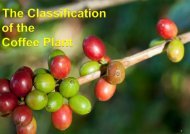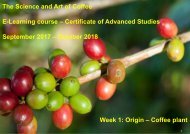You also want an ePaper? Increase the reach of your titles
YUMPU automatically turns print PDFs into web optimized ePapers that Google loves.
C<strong>of</strong>fea canephora<br />
• Increase in production, 0 % in 1920 to 40 % today<br />
• Introgression lines with C. arabica varieties<br />
• More caffeine and chlorogenic acids<br />
(higher bitterness, but quality is sufficient for soluble<br />
c<strong>of</strong>fee)<br />
Selection <strong>of</strong> trees with good general combining ability<br />
(hybrids <strong>of</strong> good quality with many different genotypes)<br />
• Guinean (West Africa, red) and Congolese group<br />
(Central Africa, green)<br />
‣ Robusta (Congo), 1890<br />
‣ Nganda (Uganda)<br />
‣ Kouilou (Central Africa),<br />
now widespread in Brazil<br />
Hybrids<br />
• BP and SA series in Java, Indonesia in <strong>the</strong><br />
1920th, propagation via seed and grafting<br />
• S274 and BR series in India in <strong>the</strong> 1950th<br />
(<strong>plant</strong> material from Java), propagation via seed<br />
Montagnon C et al. C<strong>of</strong>fee (C<strong>of</strong>fea canephora Pierre) genetic improvement: Acquired<br />
knowledge, strategies and perspectives. Cahiers Agricultures 21/2-3(2012)143–153<br />
• IF series in Ivory coast<br />
(<strong>plant</strong> material from Java)<br />
52








